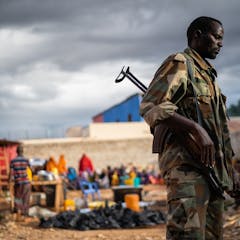
Articles sur Malaria
Affichage de 1 à 20 de 259 articles

Malaria has been around longer than humankind. The endgame for this deadly parasitic disease is in sight.

Forty million children are born in malaria areas across Africa each year. Two new vaccines are important weapons in the fight against the disease.

Two out of five cases of TB remain undiagnosed. A test using a skin patch could help change that.

Beyond the tombs and riches, life in ancient Egypt wasn’t so luxurious, after all.

Malaria in Africa accounts for 96% of deaths worldwide. Cape Verde became only the third country in Africa to be declared malaria free this year. This is how they did it.

The past two years have seen groundbreaking advances in the fight against malaria with the development of two vaccines. But demand far exceeds supply, so rollouts need to be carefully managed.

Antimicrobial resistance is an epidemic that kills close to 5 million people annually. The solutions are complex and must take into account the needs of the poor.

The Sahel region is grappling with an outbreak of the deadly mosquito-borne disease.

Currently we see more than 600,000 deaths from this mosquito-borne disease each year. This new vaccine – the second approved to treat malaria – could change things.

People have been trying to make malaria vaccines for over 100 years. With the help of the revolutionary new R21/Matrix vaccine the disease could be eradicated by 2040.

In this episode of The Conversation Weekly, we hear from the scientists behind a new malaria vaccine developed by the University of Oxford.

Methods that don’t rely on insecticides are needed to bolster the fight against mosquito-borne diseases.

After recent cases in Florida and Texas, authorities are advising the public to drain standing water sources to keep mosquitoes from multiplying.

Nigeria must do more to reduce its high malaria burden.

There have been disruptions. But national malaria control programmes have shown impressive resilience.

This whirlwind tour of social history describes how infectious diseases have shaped humanity at every stage. It suggests reducing inequality will give us our best chance of surviving future plagues.

Being able to tell the difference between good quality medicines and fakes can be a matter of life and death.

This mosquito spreads very fast to new areas and can adapt to various climatic conditions, unlike the non-invasive malaria vectors.

The motivations for Carter’s interest in Africa are deeply personal. His record should remind all democrats, including those in Africa, to hold leaders accountable to high ethical standards.

The negative effects of conflict on human capital – particularly nutrition, health and education – are larger than commonly thought.
